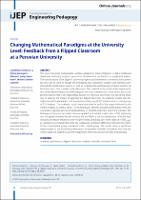| dc.contributor.author | Beltozar-Clemente, Saul | |
| dc.contributor.author | Iparraguirre-Villanueva, Orlando | |
| dc.contributor.author | Zapata-Paulini, Joselyn | |
| dc.contributor.author | Cabanillas-Carbonell, Michael | |
| dc.date.accessioned | 2023-12-20T20:46:17Z | |
| dc.date.available | 2023-12-20T20:46:17Z | |
| dc.date.issued | 2023 | |
| dc.identifier.uri | https://hdl.handle.net/20.500.13067/2887 | |
| dc.description.abstract | The university-level mathematics teaching adopted by many professors is still a traditional classroom, and many students’ perception of mathematics is that it is a complicated subject. The operationality of the flipped classroom proposal implemented at a university has a poten tial that can be used to change the perception that university students and teachers have towards the mathematics course, as well as to change the methodology of many teachers on how they teach their courses in the classroom. This research is the result of the implementa tion of the flipped classroom methodology in the basic mathematics course that is part of the professional careers of the engineering faculty of a Peruvian university. The aim of this study was to analyze the impact of applying the flipped classroom on academic results and atti tudes towards mathematics, with an experimental group of 227 students and a control group of 215 students. The academic results were measured at each of the stages indicated in the course syllabus, T1, partial exam, T2 and final exam; attitudes towards mathematics were also assessed at cognitive, procedural and affective levels at the end of the university semester. The Kolmogorov-Smirnov normality test was applied and yielded a value of p = 0.00, indicating that the grades obtained by the students did not follow a normal distribution. With the data obtained, the Mann-Whitney U test was performed, obtaining a p = 0.00 value (α = 0,052 tails). p < α makes us conclude that there are statistically significant differences between the scores of the experimental group compared to the control group. The results show a significant improvement in the academic performance and positive attitudes of students who took the course using the flipped classroom compared to those who did not use this methodology | es_PE |
| dc.format | application/pdf | es_PE |
| dc.language.iso | eng | es_PE |
| dc.publisher | International Journal of Interactive Mobile Technologies (iJIM) | es_PE |
| dc.rights | info:eu-repo/semantics/openAccess | es_PE |
| dc.rights.uri | https://creativecommons.org/licenses/by/4.0/ | es_PE |
| dc.subject | Academic performance | es_PE |
| dc.subject | Flipped classroom | es_PE |
| dc.subject | Students’ attitudes | es_PE |
| dc.subject | University level | es_PE |
| dc.title | Changing Mathematical Paradigms at the University Level: Feedback from a Flipped Classroom at a Peruvian University | es_PE |
| dc.type | info:eu-repo/semantics/article | es_PE |
| dc.identifier.journal | International Journal of Interactive Mobile Technologies (iJIM) | es_PE |
| dc.identifier.doi | https://doi.org/10.3991/ijep.v13i6.40763 | |
| dc.subject.ocde | https://purl.org/pe-repo/ocde/ford#2.02.04 | es_PE |
| dc.source.volume | 13 | es_PE |
| dc.source.issue | 6 | es_PE |
| dc.source.beginpage | 76 | es_PE |
| dc.source.endpage | 89 | es_PE |


